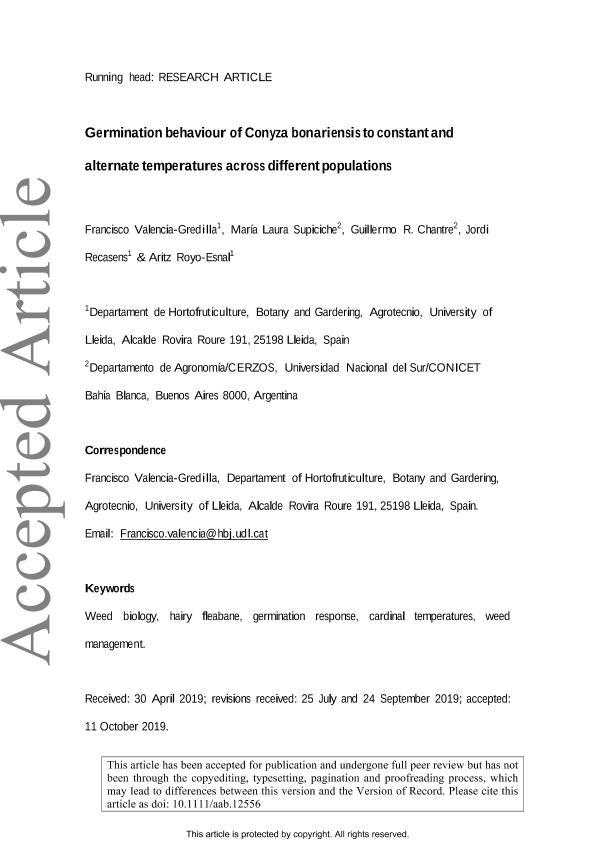Mostrar el registro sencillo del ítem
dc.contributor.author
Valencia Gredilla, Francisco
dc.contributor.author
Supiciche, María Laura

dc.contributor.author
Chantre Balacca, Guillermo Ruben

dc.contributor.author
Recasens, Jordi
dc.contributor.author
Royo Esnal, Aritz
dc.date.available
2020-06-08T20:14:33Z
dc.date.issued
2019-12
dc.identifier.citation
Valencia Gredilla, Francisco; Supiciche, María Laura; Chantre Balacca, Guillermo Ruben; Recasens, Jordi; Royo Esnal, Aritz; Germination behaviour of Conyza bonariensis to constant and alternating temperatures across different populations; Wiley Blackwell Publishing, Inc; Annals of Applied Biology; 176; 1; 12-2019; 36-46
dc.identifier.issn
0003-4746
dc.identifier.uri
http://hdl.handle.net/11336/106918
dc.description.abstract
Conyza bonariensis is one of the most problematic weed species across the world. It is considered highly noxious due to the interference with human activities, specially associated to competition with different crops. This research investigated the temperature requirements for seed germination of four different populations of C. bonariensis and the interval temperature effect in this specie. For this, different experiments were performed in growth chambers. In the first one, seeds of the four populations were maintained at constant temperatures of 5, 10, 15, 20, 25, 30 and 35ºC, and from this, we could obtain the final germination, the cardinal temperatures (base, optimum and maximum) and also the thermal time of each population. In the second experiment, we studied the influence of alternate temperatures on final germination, an important issue in annual-surface germination weeds. Seeds were exposed at different temperature regimes: 5/15, 10/20, 15/25 and 25/35ºC night/day temperature (intervals increasing 10ºC) and to 18/22, 26/24, 14/26, 12/28 and 10/30ºC night/day temperature (intervals with average of 20ºC). In general, all populations behaved similarly, with highest percentages of germination in the temperatures close to the optimum obtained (between 17.5 and 19.3ºC) both for constant and alternate temperatures. Also, germination response was accordingly with its climatic origin, where highest germination percentage at the lowest temperature assayed, were obtained from the coldest location (26.7% for Lleida). In addition, we could observe that the alternate temperatures can affect positively to total germination, especially in those ranges that are further close from the optimum temperature in its average (20ºC), with high germination percentage for all ranges and all populations . Also, the cardinal temperatures obtained shows differences across the populations. These results could help to better understand the behaviour of the specie providing valuable information to develop or improve current field emergence models.
dc.format
application/pdf
dc.language.iso
eng
dc.publisher
Wiley Blackwell Publishing, Inc

dc.rights
info:eu-repo/semantics/openAccess
dc.rights.uri
https://creativecommons.org/licenses/by-nc-sa/2.5/ar/
dc.subject
WEED BIOLOGY
dc.subject
HAIRY FLEABANE
dc.subject
GERMINATION RESPONSE
dc.subject
CARDINAL TEMPERATURES
dc.subject
WEED MANAGEMENT
dc.subject.classification
Agronomía, reproducción y protección de plantas

dc.subject.classification
Agricultura, Silvicultura y Pesca

dc.subject.classification
CIENCIAS AGRÍCOLAS

dc.title
Germination behaviour of Conyza bonariensis to constant and alternating temperatures across different populations
dc.type
info:eu-repo/semantics/article
dc.type
info:ar-repo/semantics/artículo
dc.type
info:eu-repo/semantics/publishedVersion
dc.date.updated
2020-02-26T19:31:32Z
dc.journal.volume
176
dc.journal.number
1
dc.journal.pagination
36-46
dc.journal.pais
Reino Unido

dc.journal.ciudad
Londres
dc.description.fil
Fil: Valencia Gredilla, Francisco. Universidad de Lleida; España
dc.description.fil
Fil: Supiciche, María Laura. Consejo Nacional de Investigaciones Científicas y Técnicas. Centro Científico Tecnológico Conicet - Bahía Blanca. Centro de Recursos Naturales Renovables de la Zona Semiárida. Universidad Nacional del Sur. Centro de Recursos Naturales Renovables de la Zona Semiárida; Argentina. Universidad Nacional del Sur. Departamento de Agronomía; Argentina
dc.description.fil
Fil: Chantre Balacca, Guillermo Ruben. Universidad Nacional del Sur. Departamento de Agronomía; Argentina. Consejo Nacional de Investigaciones Científicas y Técnicas. Centro Científico Tecnológico Conicet - Bahía Blanca. Centro de Recursos Naturales Renovables de la Zona Semiárida. Universidad Nacional del Sur. Centro de Recursos Naturales Renovables de la Zona Semiárida; Argentina
dc.description.fil
Fil: Recasens, Jordi. Universidad de Lleida; España
dc.description.fil
Fil: Royo Esnal, Aritz. Universidad de Lleida; España
dc.journal.title
Annals of Applied Biology

dc.relation.alternativeid
info:eu-repo/semantics/altIdentifier/url/https://onlinelibrary.wiley.com/doi/abs/10.1111/aab.12556
dc.relation.alternativeid
info:eu-repo/semantics/altIdentifier/doi/http://dx.doi.org/10.1111/aab.12556
Archivos asociados
